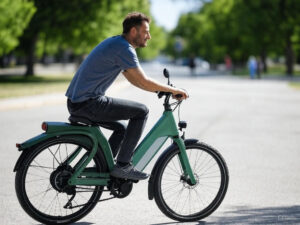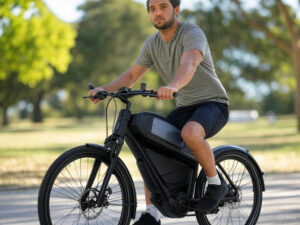Can an Electric Bike Really Go 100 Miles on a Single Charge?
Imagine riding your electric bike through a sunny park or zooming to work without ever worrying about the battery dying. Now picture this: could your e-bike really take you 100 miles on just one charge? That’s a big question for anyone who loves e-bikes or is thinking about getting one. With e-bikes popping up everywhere for fun, commuting, or saving the planet, many of us wonder how far they can go before needing a plug. The fear of a dead battery—range anxiety—is super common.
In this post, we’re going to find out if a 100-mile ride is possible. We’ll look at real tests from 2025, explain what affects your e-bike’s range, and share easy tips to go farther. Whether you’re a daily rider or dreaming of long adventures, let’s hop on and see how far we can go!


What Does “Range” Mean for an E-Bike?
Before we chase that 100-mile goal, let’s talk about what “range” is. Range is how far your e-bike can travel on a full battery, kind of like how many miles a car gets on a tank of gas. But it’s not always the same—it depends on a few things.
The heart of your e-bike is its battery, and its size is measured in watt-hours (Wh). Think of it like a water bottle: a bigger bottle (say, 500Wh) holds more “juice” than a smaller one (like 400Wh). Most e-bikes have batteries between 400 and 700Wh, which usually give you 20 to 60 miles. But hitting 100 miles? That’s a tall order.
Here’s what affects how far you can go:
- Your weight and stuff: If you’re heavier or carrying a big backpack, the motor works harder and uses more battery.
- The road: Flat, smooth paths are easy. Hills or bumpy trails make the battery drain faster.
- How much help you use: E-bikes have settings like “eco” (low help) or “turbo” (lots of help). Eco saves battery; turbo eats it up.
- Weather: Windy days or freezing temps (below 32°F) can zap your battery quicker.
- Tires: Flat or soft tires make riding harder, like pedaling through sand.
Understanding these basics is like knowing the rules of the game—it helps us see what’s possible.
Can an Electric Bike Really Go 100 Miles on a Single Charge ?? Let’s Look at Real Tests
So, is a 100-mile ride a real thing or just a dream? Good news: it’s possible! In April 2025, a company called Priority Bicycles tested their Current Plus e-bike and hit exactly 100 miles (Electrek, April 2025). They used a 720Wh battery, which got them 91.8 miles, and then added a 500Wh extra battery to finish the job. That’s a big deal!
Other e-bikes can get close, too. The Fiido L3 claims it can go up to 120 miles if everything’s perfect—like a light rider, flat roads, and low assist. Another bike, the Riese & Muller Load 75, can hit 100 miles with two big batteries. But these are special bikes with extra-powerful batteries, not the ones most people ride.
What do these tests tell us? Hitting 100 miles usually needs:
- A big battery (700Wh or more, sometimes with an extra one).
- Low assist,Rosie, the e-bike’s “best friend,” who pedals a lot to help the motor.
- Flat roads and nice weather (no hills or wind).
Most e-bikes with standard 400-500Wh batteries give you 20-60 miles in real life. So, 100 miles is like running a marathon—it’s doable, but it takes the right bike and plan. Let’s dig into what makes it work.
Can an Electric Bike Really Go 100 Miles on a Single Charge ?
What Makes or Breaks a 100-Mile Ride?
Getting to 100 miles is like baking a cake—you need the right ingredients and some skill. Here’s what matters most:
- Big Battery, Smart Motor: A huge battery, like the 960Wh one in the TESWAY Pro X7, gives you tons of power. A good motor (like a 750W hub motor) uses that power wisely, like a car that gets great gas mileage. A 500Wh battery might get 50 miles, but a 960Wh one could hit 100 if you’re careful.
- How You Ride: Use “eco” mode or low assist (Level 1) to save battery. If you use the throttle (like a gas pedal), the battery drains super fast. For example, riding in eco-mode might use only 3.1Wh per mile, so a 500Wh battery could go farther if you pedal hard.
- The Path: Flat, paved roads are your friend. Hills are like climbing stairs with a heavy bag—they tire out your battery. Rough trails or gravel do the same.
- Weather Woes: Cold weather (below 32°F) can cut your battery’s power by half. Headwinds are like an invisible wall, making the motor work harder.
- Your Effort: The more you pedal, the less the motor does, saving battery. Lighter riders (like 135 lbs) have an easier time than heavier ones (like 200 lbs).
Your choices—like pedaling more or picking flat roads—can push your e-bike closer to that 100-mile mark.
Can an Electric Bike Really Go 100 Miles on a Single Charge ?
Easy Tips to Go Farther on Your E-Bike
Want to stretch your e-bike’s range? Here are some simple tricks to try, like hacks to make your battery last longer:
- Use Less Assist: Stick to eco-mode or Level 1 assist on flat roads. It’s like sipping your drink slowly instead of chugging it.
- Keep Tires Pumped: Check your tire pressure (look at the side of the tire for the right number). Full tires roll easier, saving about 3% more battery.
- Travel Light: Skip the heavy backpack or extra gear. Less weight means less work for the motor.
- Pick a Good Route: Choose flat, smooth paths over hills or dirt trails. If it’s windy, try to ride with the wind at your back—it’s like a free push!
- Charge Up: Always start with a full battery. For super-long rides, a spare battery (like the TESWAY Pro X7’s removable one) can keep you going.
- Pedal Smoothly: Try to pedal at a steady pace, like 80-100 spins per minute. It’s easier on the motor and saves power.
These tips are like little boosts to help you ride farther. Try them out and see how many extra miles you get!
Do You Really Need 100 Miles?
Okay, so 100 miles is possible, but is it something you need? For most people, probably not. If you’re riding to work or running errands, you might only need 10-20 miles a day. Most e-bikes can handle 20-60 miles, which is plenty for that. A 100-mile range is more for people doing big adventures, like cross-country trips, or super-long commutes.
There’s a downside to chasing 100 miles. E-bikes with giant batteries (700Wh or more) cost more—sometimes over $2,000. They’re also heavier, like 50-70 pounds, which can feel like dragging a suitcase. Plus, charging a big battery takes longer, like 3-6 hours for a 500Wh one.
If you need to go far, you could try a simpler fix: carry a spare battery or charge up at work or home. That’s often easier than counting on one huge charge.
The cool thing? E-bike batteries are getting better. In a few years, we might see lighter, stronger batteries that make 100 miles no big deal. For now, think about what you really need—maybe a 30-mile range is perfect for your daily rides.
Let’s Hit the Road!
So, can an electric bike go 100 miles on a single charge? Yep, it’s totally possible! Tests like Priority’s 2025 ride show that with a big battery, smart riding, and flat roads, you can hit that goal. Even if you don’t need 100 miles, your e-bike can do a lot with a few tweaks—like using eco-mode, pumping your tires, or picking a smooth path.
Whether you’re cruising to work or dreaming of a big adventure, there’s something awesome about seeing how far your e-bike can take you. Try out the tips we shared, or check out long-range bikes like the TESWAY Pro X7 or Fiido L3 if you’re feeling ambitious. Have you pushed your e-bike to its limit? Share your story in the comments—I’d love to hear about your rides! Where would you go with a 100-mile range? Let’s keep pedaling and find out how far we can go together.